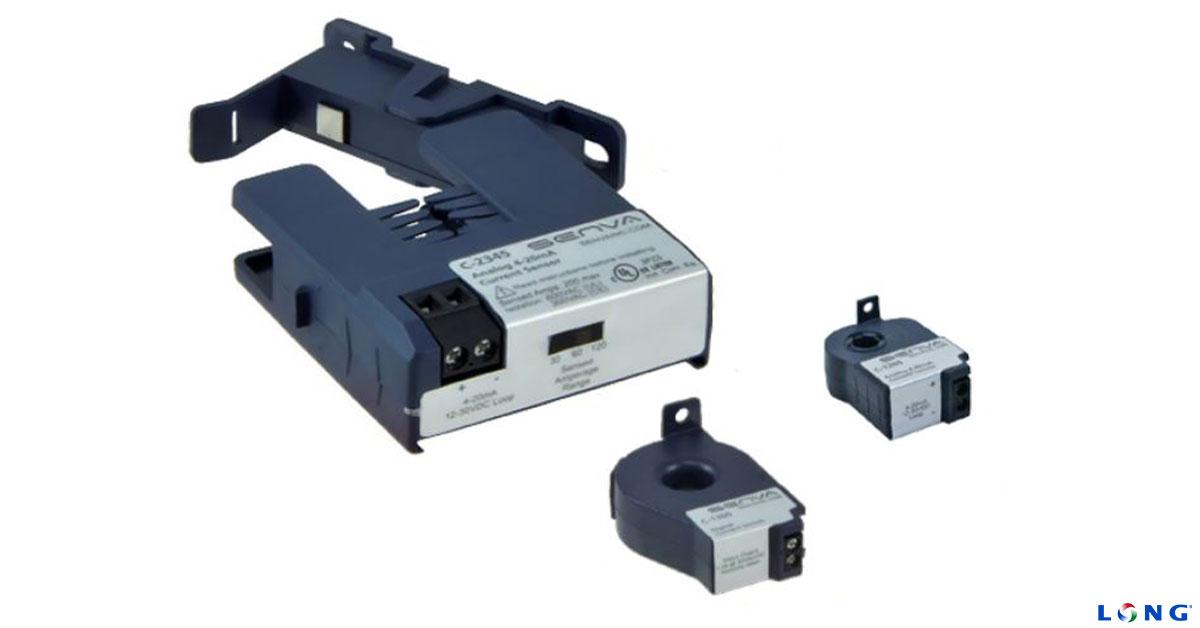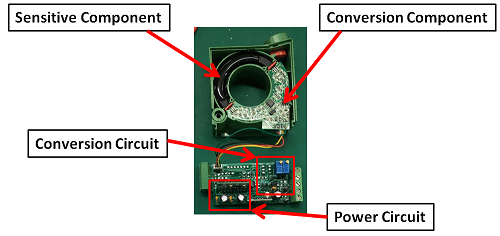
Current transducers convert AC or DC electrical current to an electrical signal. Common applications in Building Automation Systems (BAS) include digital signaling current transducers (sometimes referred to as current switches) used to send digital signals for indicating motor status (e.g., pumps or fans), or analog signal current transducers for measuring electrical usage.
How do they work?
Current transducers consist of four main components: sensitive component, conversion component, conversion circuit, and power circuit.

The current being sensed by a current transducer goes through the center of the device. The sensitive component (located within the device surrounding the current being sensed) detects the electrical current and produces a signal. The signal produced then passes to a conversion component, which converts the signal to a small current signal. Once converted to a small current signal that the conversion circuit can accept, the conversion circuit processes the small current signal to a standard BAS signal (e.g, 4-20MA, 0-5V, RS485, BACnet). Current transducers usually have a power circuit to power the conversion component and the conversion circuit. Digital signaling current transducers often do not have the power circuit, as the digital signaling output does not need a power circuit to output a digital signal.
A current transducer is a relatively simple device to install and can be done by any trained technician. It is critically important to disconnect power from the sensed current wiring prior to working on the device. A current transducer is generally a small part of a much larger system, and additional training will likely be needed to work on the rest of the system it is connected to.
Why use a current transducer?
The applications for current transducers are numerous and there are multiple benefits to utilizing them. For example, when signaling digital signals, current transducers can often take the place of an airflow or liquid flow switch to provide proof of flow. Flow switches are placed in ductwork or piping. Using a current transducer instead of a flow switch eliminates a potential leaking point in the system. Another benefit is that current transducers are available in adjustable setpoint designs. Used in lieu of an interlocking relay for motor status, the transducer will not detect status if the motor becomes disconnected from the component it powers, whereas an interlocking relay would remain powered even with said loss of connection. These adjustable trip current transducers can also be used to detect other mechanical issues such as belt slippage on fan motors.
Another benefit of using these devices is that they can save you money on energy. Analog signaling current transducers can be used to signal power consumption. These can be selected and installed to sense power consumption of an entire building all the way down to the power consumption of a light bulb, so you know exactly how much energy your building is using and can find areas in which to improve. This is helped even further by the fact that current transducers, when installed on an entire building or portion of a building, can produce tenant billings for energy consumption. More specifically, if installed to sense current on a critical, high energy use mechanical component (such as a chiller), current transducers can be brought into a BAS and an energy optimization code can be implemented to operate the equipment in the most efficient way possible.
There are a variety of current transducer options available to fit your specific needs:
Current transducers are a valuable building automation field device that have fewer points of failure than other devices, can help save you money on energy, and help to ensure your building equipment operates efficiently.
LONG not only sells current transducers, but services them as well. We have technicians available to work on the BAS and mechanical equipment that they may be installed in. Whether you need a replacement current transducer or need a technician to troubleshoot your system, LONG has you covered.
*Current transducer model image from https://www.senvainc.com/en/products/current-sensing/current-transducers
*Current transducer component image from https://www.set-transducer.com/Article-CurrentTransducer.html
Todd is the Operations Manager for our Building Automation team in Wyoming.
We are always looking for bright, ambitious new team members. Join Team LONG today!